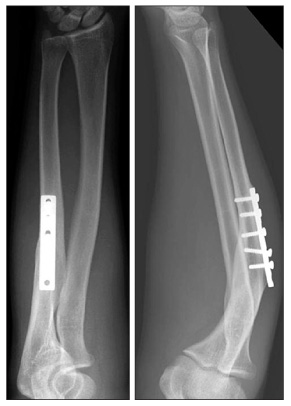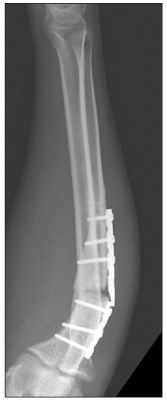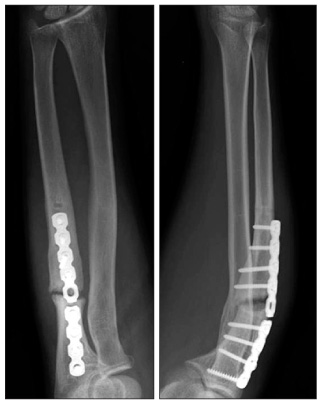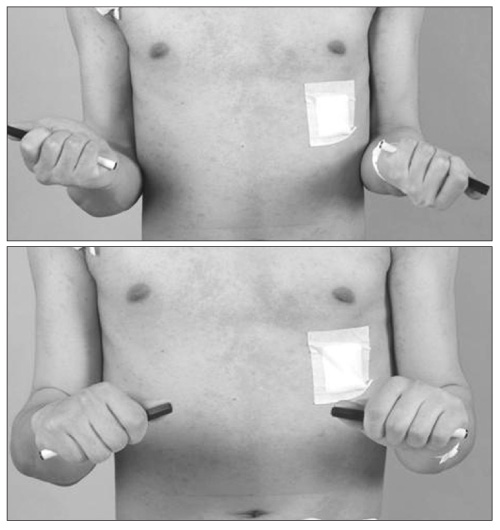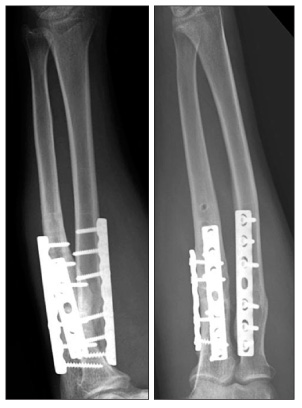J Korean Orthop Assoc.
2011 Dec;46(6):533-538.
Successful Treatment of Failed Ulnar Osteotomy by Concurrent Radial Osteotomy in a Forearm Malunion
- Affiliations
-
- 1Department of Orthopedic Surgery, Seoul National University College of Medicine, Seoul, Korea. hsgong@snu.ac.kr
Abstract
- We present a patient with malunion of the ulna and radius, who experienced 2 consecutive healing failures after osteotomy of the ulnar malunion only. The purpose of the surgery was for cosmetic reasons. Healing was fi nally obtained when a seemingly minimal malunion of the radius was corrected as well. This case suggests concurrent correction of both bone forearm malunion may be required to ensure satisfactory healing.
Keyword
Figure
Reference
-
1. Trousdale RT, Linscheid RL. Operative treatment of malunited fractures of the forearm. J Bone Joint Surg Am. 1995. 77:894–902.
Article2. van Geenen RC, Besselaar PP. Outcome after corrective osteotomy for malunited fractures of the forearm sustained in childhood. J Bone Joint Surg Br. 2007. 89:236–239.
Article3. Brakenbury PH, Corea JR, Blakemore ME. Non-union of the isolated fracture of the ulnar shaft in adults. Injury. 1981. 12:371–375.
Article4. Stern PJ, Drury WJ. Complications of plate fi xation of forearm fractures. Clin Orthop Relat Res. 1983. (175):25–29.5. Matthews LS, Kaufer H, Garver DF, Sonstegard DA. The effect on supination-pronation of angular malalignment of fractures of both bones of the forearm. J Bone Joint Surg Am. 1982. 64:14–17.
Article6. Tarr RR, Garfinkel AI, Sarmiento A. The effects of angular and rotational deformities of both bones of the forearm. An in vitro study. J Bone Joint Surg Am. 1984. 66:65–70.
Article7. Sarmiento A, Ebramzadeh E, Brys D, Tarr R. Angular deformities and forearm function. J Orthop Res. 1992. 10:121–133.
Article8. Schemitsch EH, Richards RR. The effect of malunion on functional outcome aft er plate fixation of fractures of both bones of the forearm in adults. J Bone Joint Surg Am. 1992. 74:1068–1078.9. Morrey BF, Askew LJ, Chao EY. A biomechanical study of normal functional elbow motion. J Bone Joint Surg Am. 1981. 63:872–877.
Article10. Murase T, Oka K, Moritomo H, Goto A, Yoshikawa H, Sugamoto K. Three-dimensional corrective osteotomy of malunited fractures of the upper extremity with use of a computer simulation system. J Bone Joint Surg Am. 2008. 90:2375–2389.
Article
- Full Text Links
- Actions
-
Cited
- CITED
-
- Close
- Share
- Similar articles
-
- Half-wedge osteotomy and reverse repositioning for dorsal malunion distal radius fracture: a preliminary report with a case series
- Delayed Diagnosis of Volar Dislocation of the Distal Ulna after Treatment of the Radial Shaft Fracture
- Surgical Treatment of Radial Clubhand
- A Correction of Malunion or Deformity in the Lower Extremity
- The Clinical Results of Opening Wedge Osteotomy in the Volarly Malunited Distal Radius

